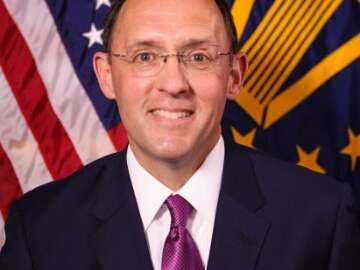
The Army IG says there are too many whistleblower reprisal cases, but that might not be bad
Whistleblower reprisal cases are going up, but that may mean whistleblowers are feelings safer coming forward.
Army Inspector General Maj. Gen. David Quantock showed raw emotion when speaking to Congress last week about whistleblowers.
Quantock said whistleblower reprisal cases increased six-fold in the past three years and he was clearly unhappy about it.
“The substantiated rate for whistleblower reprisal cases is 4 percent. A significant factor in the low 4 percent substantiated rate is misuse of the whistleblower reprisal process. This typically occurs when a soldier or civilian is held accountable by a senior official for misconduct or poor performance, following a protected communication. The resulting claim of reprisal creates challenges for senior commanders who hold people accountable, and then are faced with an Inspector General whistleblower reprisal investigation,” Quantock said at the House Armed Services Personnel Subcommittee on Feb. 7.
Quantock added “the reason why the numbers are so high from the [Defense Department] IG about the rise in complaints is because of the misapplication of whistleblower reprisal.”
But is the whistleblower process being abused or is it just working better?
Liz Hempowicz, director of policy for the Project on Government Oversight, says Quantock’s rage is misplaced.
As a reminder, reprisal cases are when whistleblowers have already come forward and then are punished by a superior for spilling the beans.
“The idea that people are claiming whistleblower status to make it easier for them inside DoD is laughable. It’s not easy to be a whistleblower. There are severe career consequences for coming forward and reporting wrongdoing,” Hempowicz said.
The military is unique in that it is the whistleblower’s responsibility to prove he or she was retaliated against and not the agency.
In the military, the whistleblowers must own up to poor performance in the past and then show they were retaliated against because they reported the misbehavior of a senior official and not because of the poor performance.
That makes it harder for whistleblower reprisal cases to get substantiated because the whistleblower must show the reprisal punishment is not being conflated with a punishment for poor performance, Hempowicz says.
“The way he characterizes this is that people are misusing the system and they’re trying to fall back on their status as a whistleblower to buttress and soften the blow of legitimate actions against [the whistleblower],” Hempowicz said.
Hempowicz pointed to a 2012 Government Accountability Office report that stated 36 percent of complaints don’t have any basis in a protected disclosure that started the whole reprisal process.
As for the 4 percent substantiation rate, Hempowicz said that number can be misleading.
“A 4 percent substantiation rate is better than the whole Department of Defense’s substantiation rate, but that’s not the sign of a healthy process. The office of special counsel, which handles a lot a whistleblower retaliation complaints on the civilian side, one of their estimates is that a good substantiation rate that shows that the process is working and the system is being implemented well is 6 [percent] to 8 percent,” Hempowicz said. “We’re not saying it should be a 100 percent or 90 percent substantiation, we understand that it’s difficult to substantiate these cases and that not all of them are going to be substantiated.”
Hempowicz noted the number of cases closed without a full investigation is important too because it contributes to the lower substantiation rate.
Hempowicz said the six-fold increase in reprisal cases is actually a good thing.
“It’s funny to say that, the people in these [IG] offices, I see why it increases the burden because their workload is going up, but an increase in disclosures is where this is coming from. Those initial whistleblower disclosures then leads to whistleblower reprisal complaints and that’s good because you want people to come forward and blow the whistle on waste, fraud, abuse and illegality in the system. When those initial complaints go up there’s almost a direct correlation that those reprisal complaints go up,” Hempowicz said.
House Armed Services Committee Personnel Subcommittee Ranking Member Jackie Speier (D-Calif.) had similar sentiments as Hempowicz.
She noted the Navy is currently embroiled in the Fat Leonard scandal, one of the biggest scandals to rock a military service, and yet no one felt able to bring it to authorities.
“Whistleblower protection, I would argue, is not enough protection and that’s why people don’t come forward because they fear there will be reprisals. There are too many people that were engaged in conduct unbecoming of officers in that case and no one called them out,” Speier said.
The DoD IG and military service IGs plead with Congress for more employees to keep up with demand during the Feb. 7 hearing.
“We have over 200 cases that are open at this time and we are just now getting to our 2016 cases so there is some lag time because of the number of investigations,” Naval Inspector General Vice Adm. Herman Shelanski said.
While the Navy held the most egregious backlog, all of the services and DoD said they were in dire need of employees to address investigation delays.
DoD Principal Deputy Inspector General Glen Fine said his 1,600 person department could easily use another 100 employees to handle investigations.
Fine was unable to provide a number of backlogged cases for the committee.
“We do have staffing issues. The complexity, the number of cases that have risen, the number of cases that we have to do, and we take them seriously, we take each of them seriously and you can only do more with less for so long. It does affect the timeliness of the investigations and how long [those under investigation] are hung up … [Inspectors general] are not the first people you think of when you need to grow the military, but you need to grow them,” Fine said.
Copyright © 2024 Federal News Network. All rights reserved. This website is not intended for users located within the European Economic Area.
Scott Maucione is a defense reporter for Federal News Network and reports on human capital, workforce and the Defense Department at-large.
Follow @smaucioneWFED




